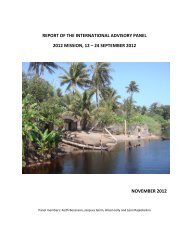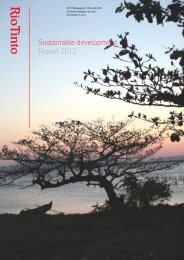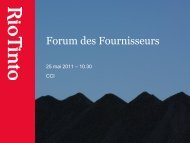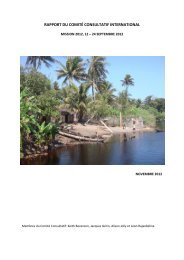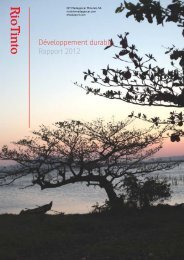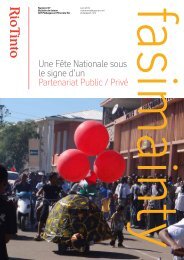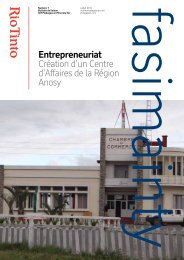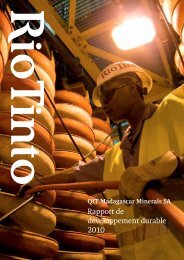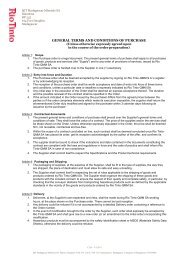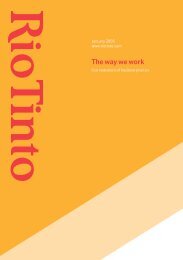Tracking Development - Rio Tinto - Qit Madagascar Minerals
Tracking Development - Rio Tinto - Qit Madagascar Minerals
Tracking Development - Rio Tinto - Qit Madagascar Minerals
Create successful ePaper yourself
Turn your PDF publications into a flip-book with our unique Google optimized e-Paper software.
executive summary<br />
To achieve a Net Positive Impact (NPI) on biodiversity,<br />
QMM has engaged in programmes including conservation,<br />
rehabilitation, restoration and natural resource management.<br />
Over 1.5 million trees have been cultivated in the region’s<br />
largest tree nursery at Mandena and replanted, providing<br />
a sustainable source of fuel for the local population and<br />
reducing pressure on remaining fragments of natural forest.<br />
To co-manage natural resources and conservation zones,<br />
the dina, a traditional and uniquely Malagasy social contract,<br />
has been established. Management committees have been<br />
formed by the communities, government and QMM in each<br />
of the mining sites to apply and enforce the dina. Recognising<br />
the importance of environmental education, especially for<br />
<strong>Madagascar</strong>’s future generations, QMM has planted green<br />
spaces around primary schools and distributed learning<br />
materials which communicate the importance of protecting<br />
<strong>Madagascar</strong>’s unique natural environment. (See The Production<br />
Phase, Managing Natural Resources, p. 54-57.)<br />
Since March 2009 <strong>Madagascar</strong> has experienced political<br />
instability. The socioeconomic repercussions have had<br />
wide-ranging impacts on the project and have complicated<br />
relationships with stakeholders, positioning QMM in a very<br />
different context than ever anticipated. Deutsche Gesellschaft<br />
für Internationale Zusammenarbeit (GIZ) and QMM have<br />
signed a partnership agreement and are working together to<br />
promote good governance and economic diversification in<br />
the communities living around mining activities. As stipulated<br />
in the Mining Code, royalties, taxes and dividends are being<br />
distributed at the national, regional and local level. GIZ and<br />
QMM are supporting the Extractive Industry’s Transparency<br />
Initiative (EITI), with capacities in participatory planning and<br />
budgeting being strengthened and public awareness about<br />
the importance of the EITI generated. (see The Production<br />
Phase, Fostering Good Governance, p. 58-59.)<br />
The QMM project is anticipated to span over 50 years,<br />
from operation to closure. QMM is investing for the longterm<br />
and remains committed to the region’s development<br />
and to the project delivering positive outcomes. QMM’s two<br />
flagship programmes, the PDI and the Fagneva programme,<br />
will continue to strengthen people’s livelihoods and promote<br />
socioeconomic development. To ensure sustainability of<br />
the programmes, QMM recommends the establishment<br />
of a regional mining foundation to capitalise on part of<br />
the royalties. Applied correctly, the foundation can be the<br />
principal vehicle to share the benefits derived from mineral<br />
production with communities and the means to work towards<br />
effective, balanced and equitable development in the Anosy<br />
region. Understanding the need to continue strengthening<br />
stakeholder engagement, a Conseil des Parties Prenantes<br />
(CPP, or Stakeholders Council) composed of government<br />
members, civil society and QMM, has been established as<br />
an important component in the recently developed Conflict<br />
Prevention Strategy. As the company’s profitability will<br />
depend on exploitation of all three orebodies, the next mining<br />
zones of Sainte Luce and Petriky will later be developed.<br />
QMM has had an active presence within these communities<br />
for many years and will continue to do so, explaining the<br />
project, preparing the population for the changes to come<br />
and building positive relations based on respect, trust and<br />
mutual understanding. (See The Future, p. 60-67.)<br />
The 230 hectare Mandena conservation zone<br />
shelters 414 plant species, 21 species of mammals,<br />
40 species of reptiles and 44 species of birds.<br />
9



